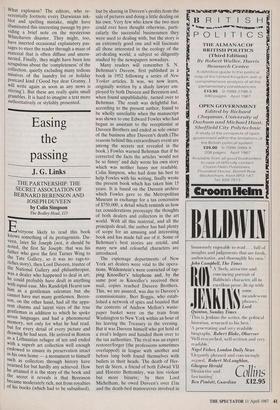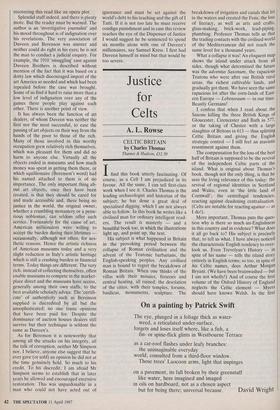Easing the passing
J. G. Links
THE PARTNERSHIP: THE SECRET ASSOCIATION OF BERNARD BERENSON AND JOSEPH DUVEEN by Conn Simpson
The Bodley Head, £15
Everyone likely to read this book knows something of its protagonists. Du- veen, later Sir Joseph (not, it should be noted, the first Sir Joseph: that was his father who gave the first Turner Wing to the Tate Gallery, so it was no rags-to- riches story), then Lord Duveen, trustee of the National Gallery and philanthropist, was a dealer who happened to deal in art; he could probably have dealt in anything With equal ease. Mrs Randolph Hearst saw him as a gentleman salesman but she cannot have met many gentlemen. Beren- son, on the other hand, had all the appa- rent charms and latent vices of the true gentleman in addition to which he spoke seven languages and had a phenomenal memory, not only for what he had read, but for every detail of every picture and drawing he had seen. He arrived in Boston as a Lithuanian refugee of ten and ended With a superb art collection well enough endowed to ensure its preservation intact in his own home — a monument to himself such as collectors through history have yearned for but hardly any achieved. How he attained it is the story of the book and the secret it reveals is that Berenson became moderately rich, not from royalties of his books (which had to be subsidised), but by sharing in Duveen's profits from the sale of pictures and doing a little dealing on his own. Very few who knew the two men could ever have thought otherwise, parti- cularly the successful businessmen they were used to dealing with, but the story is an extremely good one and will fascinate all those interested in the ecology of the art-dealing world, a subject so diligently studied by the newspapers nowadays.
Many readers will remember S. N. Behrman's Duveen, first published as a book in 1952 following a series of New Yorker articles. It was, we now learn, originally written by a shady lawyer em- ployed by both Duveen and Berenson and, when found unpublishable, turned over to Behrman. The result was delightful but, according to the present author, found to be wholly unreliable when the manuscript was shown to one Edward Fowles who had begun as assistant to the receptionist at Duveen Brothers and ended as sole owner of the business after Duveen's death.(The reasons behind this extraordinary event are among the secrets not revealed in the book.) Fowles warned Behrman that if he corrected the facts the articles 'would not be so funny' and duly wrote his own story which was neither funny nor readable. Colin Simpson, who had done his best to help Fowles with his writing, finally wrote the present book which has taken him 15 years. It is based on the Duveen archive which Fowles gave to the Metropolitan Museum in exchange for a tax concession of $750,000, a detail which reminds us how tax considerations preoccupy the thoughts of both dealers and collectors in the art world. With all this material, and all the principals dead, the author has had plenty of scope for an amusing and interesting book and has made full use of it. Some of Behrman's best stories are retold, and many new and colourful characters are introduced.
The espionage departments of New York art dealers were vital to the opera- tions. Wildenstein's were convicted of tap- ping Knoedler's' telephone and, by the same post as Knoedler's received their mail, copies reached Duveen Brothers. This, we are assured, was due to Duveen's commissionaire, Bert Boggis, who estab- lished a network of spies and boasted that the contents of Andrew Mellon's waste- paper basket were on the train from Washington to New York within an hour of his leaving the Treasury in the evening. But it was Duveen himself who got hold of a rival's ledgers and handed them over to the tax authorities. The rival was an expert restorer/forger (the professions sometimes overlapped) in league with another and before long both found themselves with bullets in their heads. The death of Her- bert de Stern, a friend of both Edwad VII and Horatio Bottomley, was less violent but more bizarre; by then Lord Michelham, he owed Duveen's over Lim and the death-bed manoeuvres involved in recovering this read like an opera plot.
Splendid stuff indeed, and there is plenty more. But the reader must be warned. The author is an 'investigative journalist' and his mood throughout is of indignation over his revelations. The very association of Duveen and Berenson was sinister and neither could do right in his eyes; he is not the man to conduct a judicial enquiry. For example, the 1910 'smuggling' case against Duveen Brothers is described without mention of the fact that it was based on a dotty law which discouraged import of the art America so needed and which had been repealed before the case was brought. Some of us find it hard to raise more than a low level of indignation over any of the games these people play against each other. There is another point of view.
It has always been the function of art dealers, of whom Duveen was neither the first nor the most successful, to ease the passing of art objects on their way from the hands of the poor to those of the rich. Many of those involved in this worthy occupation grew relatively rich themselves, which was pleasant for them and did no harm to anyone else. Virtually all the objects ended in museums and how much money was spent in getting them there, or which squillionaire (Berenson's word) had his named attached to them is of no importance. The only important thing ab- out art objects, once they have been created, is that they should be cared for and made accessible and, there being no justice in the world, the original owner, whether a crumbling monastery or a penu- rious nobleman, can seldom offer such service. Fortunately for the cause of art, American millionaires were willing to accept the burden during their lifetimes — occasionally, although not often, for aes- thetic reasons. Hence the artistic richness of American museums today and a very slight reduction in Italy's artistic heritage which is still a crushing burden in financial terms. Today things are different. The very rich, instead of collecting themselves, often enable museums to compete in the market- place direct and the museums have access, generally among their own staffs, to the best available scholarly advice. The 'certifi- cate' of authenticity such as Berenson supplied is discredited by all but the unsophisticated; no one trusts opinions that have been paid for. Despite the dominance of auction houses dealers still survive but their technique is seldom the same as Duveen's.
As for Berenson it is noteworthy that among all the attacks on his integrity, all the talk of corruption, neither Mr Simpson nor, I believe, anyone else suggest that he ever gave (or sold) an opinion he did not at the time genuinely hold. So much to his credit. To his discredit, I am afraid Mr Simpson seems to establish that in later years he allowed and encouraged excessive restoration. This was unpardonable in a man who could not have acted out of ignorance and must be set against the world's debt to his teaching and the gift of I Tatti. If it is not too late he must receive condign punishment and in case this review reaches the eye of the Dispenser of Justice I would suggest he be sentenced to spend six months alone with one of Duveen's millionaires, say Samuel Kress. I first had Duveen himself in mind but that would be too severe.

























































 Previous page
Previous page